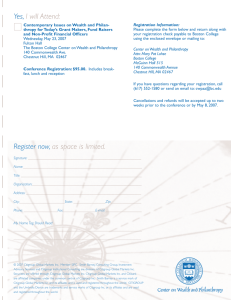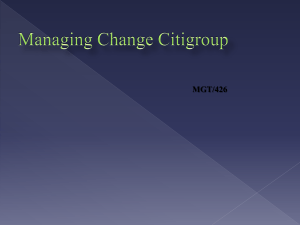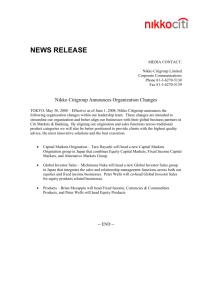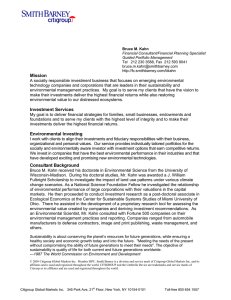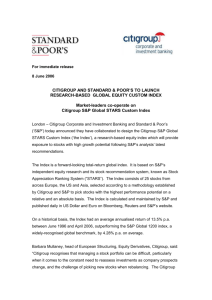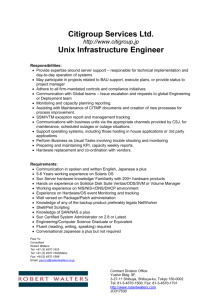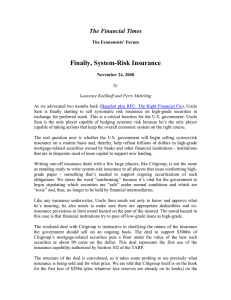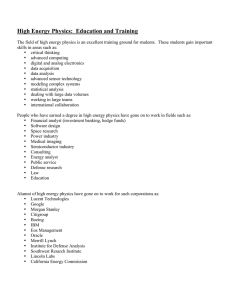Dr. Booth’s Responses to Gaz Metro’s Information Request No.1
advertisement
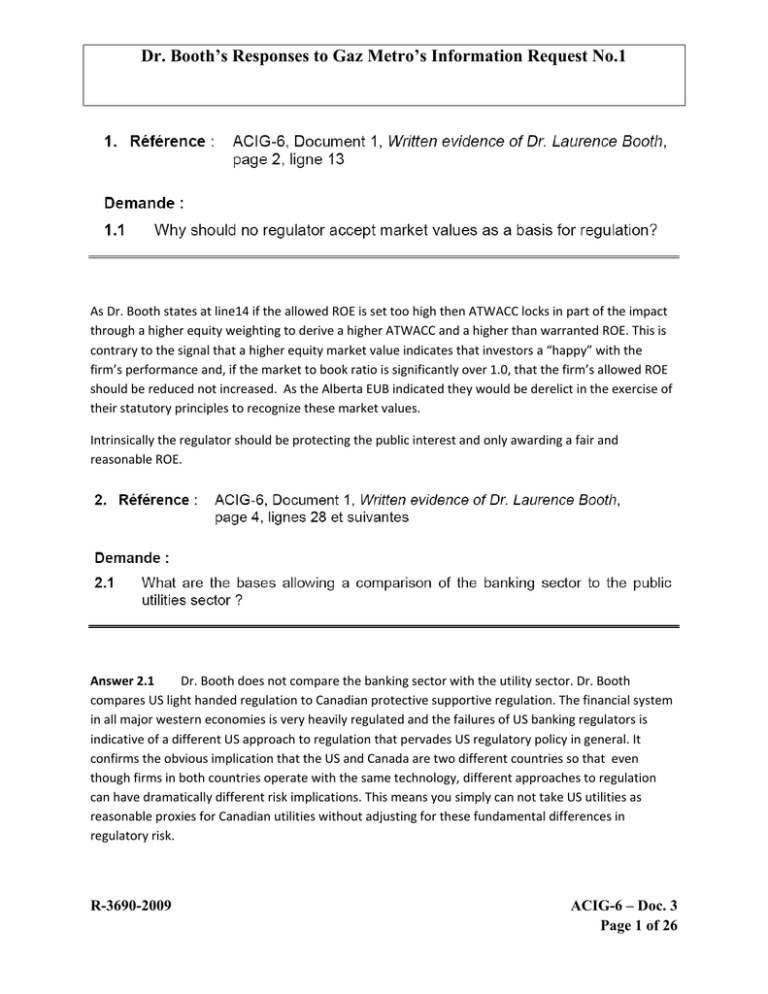
Dr. Booth’s Responses to Gaz Metro’s Information Request No.1 As Dr. Booth states at line14 if the allowed ROE is set too high then ATWACC locks in part of the impact through a higher equity weighting to derive a higher ATWACC and a higher than warranted ROE. This is contrary to the signal that a higher equity market value indicates that investors a “happy” with the firm’s performance and, if the market to book ratio is significantly over 1.0, that the firm’s allowed ROE should be reduced not increased. As the Alberta EUB indicated they would be derelict in the exercise of their statutory principles to recognize these market values. Intrinsically the regulator should be protecting the public interest and only awarding a fair and reasonable ROE. Answer 2.1 Dr. Booth does not compare the banking sector with the utility sector. Dr. Booth compares US light handed regulation to Canadian protective supportive regulation. The financial system in all major western economies is very heavily regulated and the failures of US banking regulators is indicative of a different US approach to regulation that pervades US regulatory policy in general. It confirms the obvious implication that the US and Canada are two different countries so that even though firms in both countries operate with the same technology, different approaches to regulation can have dramatically different risk implications. This means you simply can not take US utilities as reasonable proxies for Canadian utilities without adjusting for these fundamental differences in regulatory risk. R-3690-2009 ACIG-6 – Doc. 3 Page 1 of 26 Answer 3.1 and 59-62. The beta estimates and price performance of Canadian utilities provided on pages 51-56 Answer 4.1 The professional judgment as indicated in the survey of Professors of Finance by Fernandez discussed on pages 65-67. This indicates that Dr. Vilbert’s estimate of the market risk premium of 7.75% is in the extreme tail of the distribution of MRP estimates where only 2 out of 29 professors of Finance in Canada believe that the MRP is this high. Answer 5.1 this area. R-3690-2009 Professors of Finance worldwide, particularly in Canada who have studied and teach in ACIG-6 – Doc. 3 Page 2 of 26 Answer 6.1 This is a very broad question and Dr. Booth is not a lawyer with expertise in the legal interpretation of any Board’s responsibilities. Dr. Booth accepts that it is the responsibility of each utility Board to interpret the act under which their utilities are regulated. This normally means that rates have to be “fair and reasonable” or “just and reasonable.” As the AEUB noted (Decision U99099, page 301) “the Board considers that beta and the cost of equity do not change to the extent necessary for an ATWACC, determined from market capitalization weights, to remain constant when applied to the book capitalization for a pure play regulated utility. The increase required to the cost of equity to achieve a constant ATWACC would be excessive and violate the fair return standard.” Dr. Booth judges the AEUB’s responsibilities in terms of this “fair return” standard. Answer 7.1 Finance. R-3690-2009 The professional judgment as indicated in the 2009 survey of Professors of ACIG-6 – Doc. 3 Page 3 of 26 Answer 8.1 Yes. Unfortunately this a typo that sipped in. Dr. Booth normally uses the subscript D to mean debt but in this testimony he is using D to indicate the book values or embedded cost of debt and B to indicate market values. Answer 9.1 Dr. Booth assumes that the NEB felt that it made the correct decision. Why he uses the word felt is that there is very little documentation of their 6.4% ATWACC, it comes out of thin air as the following statement indicates (decision, page 80): Answer 9.2 R-3690-2009 In footnote 38 on page 81 the NEB states ACIG-6 – Doc. 3 Page 4 of 26 Clearly the NEB felt the need to justify the ATWACC by converting it into a conventional ROE & Capital structure award. Answer 9.3 Yes that is clear from the footnote referenced in 9.2 above and the closeness of TQM’s embedded interest cost to market rates. Answer 9.4 Traditional allowed ROE on a deemed common equity base plus embedded interest costs. Answer 10.1 Dr. Booth’s understanding is that the TransCanada Mainline negotiated a 40% common equity ratio in a settlement agreement with CAPP that the NEB has accepted. Dr. Booth is not aware of a formal NEB decision which is why he used the word “accepted” Answer 11.1 It is based on market value weights which the AEUB indicated it would be derelict in the exercise of its statutory responsibilities to accept. Regulation is not designed to “rubber stamp” market values, but instead protect the public interest. However, as Dr. Booth has pointed out it is possible for an ATWACC to give identical results to traditional rate of return regulation; the major problem is the critical assumption used by Drs Kolbe and Vilbert that the ATWACC is constant. This is what generates their very high returns: estimating the ATWACC of a sample of firms and then adjusting it assuming a constant ATWACC to apply to the regulated firm. It is this adjustment that the Alberta EUB stated produce estimates that violate the fair return standard. R-3690-2009 ACIG-6 – Doc. 3 Page 5 of 26 Answer 12.1 As the AEUB references indicate there are fundamental problems with using ATWACC which the NEB brushed under the carpet. This seems to be because TQM’s debt cost was close to market and its tax rate close to the marginal statutory rate. Since ATWACC was specific to TQM for two years Dr. Booth views it as problematic in terms of a precedent. He would advise the Regie to continue with traditional rate making practices and if it is interested in ATWACC at least wait until the NEB examines all of the subtleties of ATWACC which affect the other class 1 pipelines, like the Mainline, but not TQM. These issues were not raised in the TQM hearing to any substantial degree since it seemed from previous NEB decisions that ATWACC was a dead issue. Answer 13.1 That the NEB use of ATWACC uses the market cost of debt and does not add flotation costs on top of the ATWACC. As the Gaz Metro answer on page 24 of Dr, Booth’s testimony indicates the result can be a lower ROE than generated by traditional regulation. With multiple class 1 pipelines with different embedded debt costs and tax rates the result can be significantly different ROEs for utilities of similar risk, which seems to violate the fair return standard. Dr. Booth also sees little reason to change regulatory policy in Canada to make shareholders rather than ratepayers bear the financing risk attached to issuing long term debt. This is an important issue that has not been adequately addressed. R-3690-2009 ACIG-6 – Doc. 3 Page 6 of 26 Answer 14.1 THE RECKONING Citigroup Pays for a Rush to Risk By ERIC DASH and JULIE CRESWELL "Our job is to set a tone at the top to incent people to do the right thing and to set up safety nets to catch people who make mistakes or do the wrong thing and correct those as quickly as possible. And it is working. It is working." Charles O. Prince III, Citigroup's chief executive, in 2006 In September 2007, with Wall Street confronting a crisis caused by too many souring mortgages, Citigroup executives gathered in a wood-paneled library to assess their own well-being. There, Citigroup's chief executive, Charles O. Prince III, learned for the first time that the bank owned about $43 billion in mortgage-related assets. He asked Thomas G. Maheras, who oversaw trading at the bank, whether everything was O.K. Mr. Maheras told his boss that no big losses were looming, according to people briefed on the meeting who would speak only on the condition that they not be named. For months, Mr. Maheras's reassurances to others at Citigroup had quieted internal concerns about the bank's vulnerabilities. But this time, a riskmanagement team was dispatched to more rigorously examine Citigroup's R-3690-2009 ACIG-6 – Doc. 3 Page 7 of 26 huge mortgage-related holdings. They were too late, however: within several weeks, Citigroup would announce billions of dollars in losses. Normally, a big bank would never allow the word of just one executive to carry so much weight. Instead, it would have its risk managers aggressively look over any shoulder and guard against trading or lending excesses. But many Citigroup insiders say the bank's risk managers never investigated deeply enough. Because of longstanding ties that clouded their judgment, the very people charged with overseeing deal makers eager to increase short-term earnings — and executives' multimillion-dollar bonuses — failed to rein them in, these insiders say. Today, Citigroup, once the nation's largest and mightiest financial institution, has been brought to its knees by more than $65 billion in losses, write-downs for troubled assets and charges to account for future losses. More than half of that amount stems from mortgage-related securities created by Mr. Maheras's team — the same products Mr. Prince was briefed on during that 2007 meeting. Citigroup's stock has plummeted to its lowest price in more than a decade, closing Friday at $3.77. At that price the company is worth just $20.5 billion, down from $244 billion two years ago. Waves of layoffs have accompanied that slide, with about 75,000 jobs already gone or set to disappear from a work force that numbered about 375,000 a year ago. Burdened by the losses and a crisis of confidence, Citigroup's future is so uncertain that regulators in New York and Washington held a series of emergency meetings late last week to discuss ways to help the bank right itself. And as the credit crisis appears to be entering another treacherous phase despite a $700 billion federal bailout, Citigroup's woes are emblematic of the haphazard management and rush to riches that enveloped all of Wall Street. All across the banking business, easy profits and a booming housing market led many prominent financiers to overlook the dangers they courted. R-3690-2009 ACIG-6 – Doc. 3 Page 8 of 26 While much of the damage inflicted on Citigroup and the broader economy was caused by errant, high-octane trading and lax oversight, critics say, blame also reaches into the highest levels at the bank. Earlier this year, the Federal Reserve took the bank to task for poor oversight and risk controls in a report it sent to Citigroup. The bank's downfall was years in the making and involved many in its hierarchy, particularly Mr. Prince and Robert E. Rubin, an influential director and senior adviser. Citigroup insiders and analysts say that Mr. Prince and Mr. Rubin played pivotal roles in the bank's current woes, by drafting and blessing a strategy that involved taking greater trading risks to expand its business and reap higher profits. Mr. Prince and Mr. Rubin both declined to comment for this article. When he was Treasury secretary during the Clinton administration, Mr. Rubin helped loosen Depression-era banking regulations that made the creation of Citigroup possible by allowing banks to expand far beyond their traditional role as lenders and permitting them to profit from a variety of financial activities. During the same period he helped beat back tighter oversight of exotic financial products, a development he had previously said he was helpless to prevent. And since joining Citigroup in 1999 as a trusted adviser to the bank's senior executives, Mr. Rubin, who is an economic adviser on the transition team of President-elect Barack Obama, has sat atop a bank that has been roiled by one financial miscue after another. Citigroup was ensnared in murky financial dealings with the defunct energy company Enron, which drew the attention of federal investigators; it was criticized by law enforcement officials for the role one of its prominent research analysts played during the telecom bubble several years ago; and it found itself in the middle of regulatory violations in Britain and Japan. R-3690-2009 ACIG-6 – Doc. 3 Page 9 of 26 For a time, Citigroup's megabank model paid off handsomely, as it rang up billions in earnings each quarter from credit cards, mortgages, merger advice and trading. But when Citigroup's trading machine began churning out billions of dollars in mortgage-related securities, it courted disaster. As it built up that business, it used accounting maneuvers to move billions of dollars of the troubled assets off its books, freeing capital so the bank could grow even larger. Because of pending accounting changes, Citigroup and other banks have been bringing those assets back in-house, raising concerns about a new round of potential losses. To some, the misery at Citigroup is no surprise. Lynn Turner, a former chief accountant with the Securities and Exchange Commission, said the bank's balkanized culture and pell-mell management made problems inevitable. "If you're an entity of this size," he said, "if you don't have controls, if you don't have the right culture and you don't have people accountable for the risks that they are taking, you're Citigroup." Questions on Oversight Though they carry less prestige and are paid less than Wall Street traders and bankers, risk managers can wield significant clout. Their job is to monitor trading floors and inquire about how a bank's money is being invested, so they can head off potential problems before blow-ups occur. Though risk managers and traders work side by side, they can have an uncomfortable coexistence because the monitors can put a brake on trading. That is the way it works in theory. But at Citigroup, many say, it was a bit different. David C. Bushnell was the senior risk officer who, with help from his staff, was supposed to keep an eye on the bank's bond trading business and its multibillion-dollar portfolio of mortgage-backed securities. Those activities were part of what the bank called its fixed-income business, which Mr. Maheras supervised. R-3690-2009 ACIG-6 – Doc. 3 Page 10 of 26 One of Mr. Maheras's trusted deputies, Randolph H. Barker, helped oversee the huge build-up in mortgage-related securities at Citigroup. But Mr. Bushnell, Mr. Maheras and Mr. Barker were all old friends, having climbed the bank's corporate ladder together. It was common in the bank to see Mr. Bushnell waiting patiently — sometimes as long as 45 minutes — outside Mr. Barker's office so he could drive him home to Short Hills, N.J., where both of their families lived. The two men took occasional fly-fishing trips together; one expedition left them stuck on a lake after their boat ran out of gas. Because Mr. Bushnell had to monitor traders working for Mr. Barker's bond desk, their friendship raised eyebrows inside the company among those concerned about its controls. After all, traders' livelihoods depended on finding new ways to make money, sometimes using methods that might not be in the bank's long-term interests. But insufficient boundaries were established in the bank's fixed-income unit to limit potential conflicts of interest involving Mr. Bushnell and Mr. Barker, people inside the bank say. Indeed, some at Citigroup say that if traders or bankers wanted to complete a potentially profitable deal, they could sometimes rely on Mr. Barker to convince Mr. Bushnell that it was a risk worth taking. Risk management "has to be independent, and it wasn't independent at Citigroup, at least when it came to fixed income," said one former executive in Mr. Barker's group who, like many other people interviewed for this article, insisted on anonymity because of pending litigation against the bank or to retain close ties to their colleagues. "We used to say that if we wanted to get a deal done, we needed to convince Randy first because he could get it through." Others say that Mr. Bushnell's friendship with Mr. Maheras may have presented a similar blind spot. R-3690-2009 ACIG-6 – Doc. 3 Page 11 of 26 "Because he has such trust and faith in these guys he has worked with for years, he didn't ask the right questions," a former senior Citigroup executive said, referring to Mr. Bushnell. Mr. Bushnell and Mr. Barker did not return repeated phone calls seeking comment. Mr. Maheras declined to comment. For some time after Sanford I. Weill, an architect of the merger that created Citigroup a decade ago, took control of Citigroup, he toned down the bank's bond trading. But in late 2002, Mr. Prince, who had been Mr. Weill's longtime legal counsel, was put in charge of Citigroup's corporate and investment bank. According to a former Citigroup executive, Mr. Prince started putting pressure on Mr. Maheras and others to increase earnings in the bank's trading operations, particularly in the creation of collateralized debt obligations, or C.D.O.'s — securities that packaged mortgages and other forms of debt into bundles for resale to investors. Because C.D.O.'s included so many forms of bundled debt, gauging their risk was particularly tricky; some parts of the bundle could be sound, while others were vulnerable to default. "Chuck Prince going down to the corporate investment bank in late 2002 was the start of that process," a former Citigroup executive said of the bank's big C.D.O. push. "Chuck was totally new to the job. He didn't know a C.D.O. from a grocery list, so he looked for someone for advice and support. That person was Rubin. And Rubin had always been an advocate of being more aggressive in the capital markets arena. He would say, 'You have to take more risk if you want to earn more.' " It appeared to be a good time for building up Citigroup's C.D.O. business. As the housing market around the country took flight, the C.D.O. market also grew apace as more and more mortgages were pooled together into newfangled securities. From 2003 to 2005, Citigroup more than tripled its issuing of C.D.O.'s, to more than $20 billion from $6.28 billion, and Mr. Maheras, Mr. Barker and R-3690-2009 ACIG-6 – Doc. 3 Page 12 of 26 others on the C.D.O. team helped transform Citigroup into one of the industry's biggest players. Firms issuing the C.D.O.'s generated fees of 0.4 percent to 2.5 percent of the amount sold — meaning Citigroup made up to $500 million in fees from the business in 2005 alone. Even as Citigroup's C.D.O. stake was expanding, its top executives wanted more profits from that business. Yet they were not running a bank that was up to all the challenges it faced, including properly overseeing billions of dollars' worth of exotic products, according to Citigroup insiders and regulators who later criticized the bank. When Mr. Prince was put in charge in 2003, he presided over a mess of warring business units and operational holes, particularly in critical areas like risk-management and controls. "He inherited a gobbledygook of companies that were never integrated, and it was never a priority of the company to invest," said Meredith A. Whitney, a banking analyst who was one of the company's early critics. "The businesses didn't communicate with each other. There were dozens of technology systems and dozens of financial ledgers." Problems with trading and banking oversight at Citigroup became so dire that the Federal Reserve took the unusual step of telling the bank it could make no more acquisitions until it put its house in order. In 2005, stung by regulatory rebukes and unable to follow Mr. Weill's penchant for expanding Citigroup's holdings through rapid-fire takeovers, Mr. Prince and his board of directors decided to push even more aggressively into trading and other business that would allow Citigroup to continue expanding the bank internally. One person who helped push Citigroup along this new path was Mr. Rubin. Pushing Growth R-3690-2009 ACIG-6 – Doc. 3 Page 13 of 26 Robert Rubin has moved seamlessly between Wall Street and Washington. After making his millions as a trader and an executive at Goldman Sachs, he joined the Clinton administration. Mr. Weill, as Citigroup's chief, wooed Mr. Rubin to join the bank after Mr. Rubin left Washington. Mr. Weill had been involved in the financial services industry's lobbying to persuade Washington to loosen its regulatory hold on Wall Street. As chairman of Citigroup's executive committee, Mr. Rubin was the bank's resident sage, advising top executives and serving on the board while, he insisted repeatedly, steering clear of daily management issues. "By the time I finished at Treasury, I decided I never wanted operating responsibility again," he said in an interview in April. Asked then whether he had made any mistakes during his tenure at Citigroup, he offered a tentative response. "I've thought a lot about that," he said. "I honestly don't know. In hindsight, there are a lot of things we'd do differently. But in the context of the facts as I knew them and my role, I'm inclined to think probably not." Besides, he said, it was impossible to get a complete handle on Citigroup's vulnerabilities unless you dealt with the trades daily. "There is no way you would know what was going on with a risk book unless you're directly involved with the trading arena," he said. "We had highly experienced, highly qualified people running the operation." But while Mr. Rubin certainly did not have direct responsibility for a Citigroup unit, he was an architect of the bank's strategy. In 2005, as Citigroup began its effort to expand from within, Mr. Rubin peppered his colleagues with questions as they formulated the plan. According to current and former colleagues, he believed that Citigroup was falling behind rivals like Morgan Stanley and Goldman, and he pushed to bulk up the bank's high-growth fixed-income trading, including the C.D.O. business. R-3690-2009 ACIG-6 – Doc. 3 Page 14 of 26 Former colleagues said Mr. Rubin also encouraged Mr. Prince to broaden the bank's appetite for risk, provided that it also upgraded oversight — though the Federal Reserve later would conclude that the bank's oversight remained inadequate. Once the strategy was outlined, Mr. Rubin helped Mr. Prince gain the board's confidence that it would work. After that, the bank moved even more aggressively into C.D.O.'s. It added to its trading operations and snagged crucial people from competitors. Bonuses doubled and tripled for C.D.O. traders. Mr. Barker drew pay totaling $15 million to $20 million a year, according to former colleagues, and Mr. Maheras became one of Citigroup's most highly compensated employees, earning as much as $30 million at the peak — far more than top executives like Mr. Bushnell in the risk-management department. In December 2005, with Citigroup diving into the C.D.O. business, Mr. Prince assured analysts that all was well at his bank. "Anything based on human endeavor and certainly any business that involves risk-taking, you're going to have problems from time to time," he said. "We will run our business in a way where our credibility and our reputation as an institution with the public and with our regulators will be an asset of the company and not a liability." Yet as the bank's C.D.O. machine accelerated, its risk controls fell further behind, according to former Citigroup traders, and risk managers lacked clear lines of reporting. At one point, for instance, risk managers in the fixedincome division reported to both Mr. Maheras and Mr. Bushnell — setting up a potential conflict because that gave Mr. Maheras influence over employees who were supposed to keep an eye on his traders. C.D.O.'s were complex, and even experienced managers like Mr. Maheras and Mr. Barker underestimated the risks they posed, according to people with direct knowledge of Citigroup's business. Because of that, they put blind faith in the passing grades that major credit-rating agencies bestowed on the debt. R-3690-2009 ACIG-6 – Doc. 3 Page 15 of 26 While the sheer size of Citigroup's C.D.O. position caused concern among some around the trading desk, most say they kept their concerns to themselves. "I just think senior managers got addicted to the revenues and arrogant about the risks they were running," said one person who worked in the C.D.O. group. "As long as you could grow revenues, you could keep your bonus growing." To make matters worse, Citigroup's risk models never accounted for the possibility of a national housing downturn, this person said, and the prospect that millions of homeowners could default on their mortgages. Such a downturn did come, of course, with disastrous consequences for Citigroup and its rivals on Wall Street. Even as the first shock waves of the subprime mortgage crisis hit Bear Stearns in June 2007, Citigroup's top executives expressed few concerns about their bank's exposure to mortgage-linked securities. In fact, when examiners from the Securities and Exchange Commission began scrutinizing Citigroup's subprime mortgage holdings after Bear Stearns's problems surfaced, the bank told them that the probability of those mortgages defaulting was so tiny that they excluded them from their risk analysis, according to a person briefed on the discussion who would speak only without being named. Later that summer, when the credit markets began seizing up and values of various C.D.O.'s began to plummet, Mr. Maheras, Mr. Barker and Mr. Bushnell participated in a meeting to review Citigroup's exposure. The slice of mortgage-related securities held by Citigroup was "viewed by the rating agencies to have an extremely low probability of default (less than .01%)," according to Citigroup slides used at the meeting and reviewed by The New York Times. Around the same time, Mr. Maheras continued to assure his colleagues that the bank "would never lose a penny," according to an executive who spoke to him. R-3690-2009 ACIG-6 – Doc. 3 Page 16 of 26 In mid-September 2007, Mr. Prince convened the meeting in the small library outside his office to gauge Citigroup's exposure. Mr. Maheras assured the group, which included Mr. Rubin and Mr. Bushnell, that Citigroup's C.D.O. position was safe. Mr. Prince had never questioned the ballooning portfolio before this because no one, including Mr. Maheras and Mr. Bushnell, had warned him. But as the subprime market plunged further, Citigroup's position became more dire — even though the firm held onto the belief that its C.D.O.'s were safe. On Oct. 1, it warned investors that it would write off $1.3 billion in subprime mortgage-related assets. But of the $43 billion in C.D.O.'s it had on its books, it wrote off only about $95 million, according to a person briefed on the situation. Soon, however, C.D.O. prices began to collapse. Credit-rating agencies downgraded C.D.O.'s, threatening Citigroup's stockpile. A week later, Merrill Lynch aggressively marked down similar securities, forcing other banks to face reality. By early November, Citigroup's anticipated write-downs ballooned to $8 billion to $11 billion. Mr. Barker and Mr. Maheras lost their jobs, as Mr. Bushnell did later on. And on Nov. 4, Mr. Prince told the board that he, too, would resign. Although Mr. Prince received no severance, he walked away with Citigroup stock valued then at $68 million — along with a cash bonus of about $12.5 million for 2007. Putting Out Fires Mr. Prince was replaced last December by Vikram S. Pandit, a former money manager and investment banker whom Mr. Rubin had earlier recruited in a senior role. Since becoming chief executive, Mr. Pandit has been scrambling to put out fires and repair Citigroup's deficient risk-management systems. R-3690-2009 ACIG-6 – Doc. 3 Page 17 of 26 Earlier this year, Federal Reserve examiners quietly presented the bank with a scathing review of its risk-management practices, according to people briefed on the situation. Citigroup executives responded with a 25-page single-spaced memo outlining a sweeping overhaul of the bank's risk management. In May, Brian Leach, Citigroup's new chief risk officer, told analysts that his bank had greatly improved oversight and installed several new risk managers. He said he wanted to ensure "that Citi takes the lessons learned from recent events and makes critical enhancements to its risk management frameworks. A change in culture is required at Citi." Meanwhile, regulators have criticized the banking industry as a whole for relying on outsiders — in particular the ratings agencies — to help them gauge the risk of their investments. "There is really no excuse for institutions that specialize in credit risk assessment, like large commercial banks, to rely solely on credit ratings in assessing credit risk," John C. Dugan, the head of the Office of the Comptroller of the Currency, the chief federal bank regulator, said in a speech earlier this year. But he noted that what caused the largest problem for some banks was that they retained dangerously big positions in certain securities — like C.D.O.'s — rather than selling them off to other investors. "What most differentiated the companies sustaining the biggest losses from the rest was their willingness to hold exceptionally large positions on their balance sheets which, in turn, led to exceptionally large losses," he said. Mr. Dugan did not mention any specific bank by name, but Citigroup is the largest player in the C.D.O. business of any bank the comptroller regulates. For his part, Mr. Pandit faces the twin challenge of rebuilding investor confidence while trying to fix the company's myriad problems. R-3690-2009 ACIG-6 – Doc. 3 Page 18 of 26 Citigroup has suffered four consecutive quarters of multibillion-dollar losses as it has written down billions of dollars of the mortgage-related assets it held on its books. But investors worry there is still more to come, and some board members have raised doubts about Mr. Pandit's leadership, according to people briefed on the situation. Citigroup still holds $20 billion of mortgage-linked securities on its books, the bulk of which have been marked down to between 21 cents and 41 cents on the dollar. It has billions of dollars of giant buyout and corporate loans. And it also faces a potential flood of losses on auto, mortgage and credit card loans as the global economy plunges into a recession. Also, hundreds of billions of dollars in dubious assets that Citigroup held off its balance sheet is now starting to be moved back onto its books, setting off yet another potential problem. The bank has already put more than $55 billion in assets back on its balance sheet. It now says an added $122 billion of assets related to credit cards and possibly billions of dollars of other assets will probably come back on the books. Even though Citigroup executives insist that the bank can ride out its current difficulties, and that the repatriated assets pose no threat, investors have their doubts. Because analysts do not have a complete grip on the quality of those assets, they are warning that Citigroup may have to set aside billions of dollars to guard against losses. In fact, some analysts say they believe that the $25 billion that the federal government invested in Citigroup this fall might not be enough to stabilize it. Others say the fact that such huge amounts have yet to steady the bank is a reflection of the severe damage caused by Citigroup's appetites. "They pushed to get earnings, but in doing so, they took on more risk than they probably should have if they are going to be, in the end, a bank subject to R-3690-2009 ACIG-6 – Doc. 3 Page 19 of 26 regulatory controls," said Roy Smith, a professor at the Stern School of Business at New York University. "Safe and soundness has to be no less important than growth and profits but that was subordinated by these guys." Answer 15.1 Dr. Booth is aware that witnesses on behalf of utilities frequently use sample selection screens to reduce the total population of companies to a sample which invariably has much higher earned ROEs than that of companies in general. Dr. Booth believes that it is very important to understand what the population looks like before the application of these screens which is what the graph on page 47 indicates. Answer 15.2 No. Only for utilities is the book value an economically meaningful number, since it is the basis for traditional ROE regulation. However, with low periods of inflation book values have become more meaningful even for non-rate of return regulated companies than they were say 20 years ago. Answer 15.3 Dr. Booth is not aware of any and regardless the question would have to be more tightly focused for a literature review. Dr. Booth looks at accounting ROEs as a profit indicator, similar to the level of profits to GDP, as part of his discussion of the business cycle not as a basis for setting allowed ROEs for utilities. R-3690-2009 ACIG-6 – Doc. 3 Page 20 of 26 Answer 16.1 Dr. Booth would put Gaz Metro closer to a pure regulated utility than the typical traded UHC in Canada. However, Gaz Metro has significant assets other than those regulated by the Regie. Answer 17.1 Pipeline companies weather darkest hour Executives say crisis worst in oilpatch history Shaun Polczer, Calgary Herald Published: Tuesday, December 09, 2008 Calgary's energy sector is facing the worst downturn in its history -- even worse than the devastating busts of the 1980s--say the heads of Canada's largest and oldest oil pipeline companies. In an interview, Enbridge Inc. CEO Pat Daniel said the combination of falling commodity prices and the ongoing global financial crisis has resulted in what amounts to the oilpatch's darkest hour. "I think -- no, I won't think -- this is the worst I've experienced in my entire career," he said emphatically. "When you go from$150 (US) crude to $50, that's the biggest absolute drop in history. This is the worst of the hard times we've ever had . . . I hope we've seen the worst of it, but it's really hard to know." R-3690-2009 ACIG-6 – Doc. 3 Page 21 of 26 Likewise, TransCanada president Hal Kvisle acknowledged the impact of the economic meltdown on his customers and the company's role in broadening markets for the country's oil and gas. "Clearly we're in a 12-to 24-month period of contraction--in everything," he said. "Financial markets are in as difficult shape as I've ever seen them." Although pipelines are relatively immune from the daily gyrations of financial markets, their customers aren't. Oilsands producers such as Shell Canada, Petro-Canada, Nexen Inc. and others have blamed falling oil prices, uncertain financial markets and high capital costs for decisions to delay major new projects and expansions of existing ones. Last Wednesday, StatoilHydro, the Norwegian state oil company, withdrew a regulatory application for a proposed $4-billion upgrader to accompany its integrated mining project, the latest in a string of cancellations and deferrals. Earlier this month, Enbridge said it was mothballing work on the Fort Hills pipeline system after Petro-Canada delayed the mining portion of the project and postponed the accompanying upgrader. Daniel said Fort Hills is worth about $2 billion to his company, but remained confident it will go ahead when markets improve. Although he expects more delays, "it will not change the basic story" of the oilsands, which are home to the second-largest oil reserves outside Saudi Arabia. "It will happen, it'll just be pushed out a little bit. To my mind, there will be every bit as much of a need for oilsands development as there ever was." In addition to oil and gas producers, TransCanada's customers include mainstays of the national economy in Central Canada--big power consumers such as the automobile and manufacturing sectors in Ontario that use electricity generated from natural gas. In addition, TransCanada is a major shareholder in Bruce Power, the country's largest nuclear power producer. In a recession, Kvisle said, power demand, and in turn demand for natural gas, is the first to fall. "But I believe natural gas demand will be the first thing to come back from a downturn like this." Despite the turmoil roiling the oilpatch, pipelines have managed to weather the downturn quite handily. Although each CEO agreed it is more difficult to raise money for billions of dollars in new capital projects, TransCanada on Friday said a $1.16-billion share offering was oversubscribed by more than $150 million, a point Kvisle said underscores the attractiveness of infrastructure investments in troubled times. Enbridge, meanwhile, increased its dividend by 12 per cent and upped its 2009 earnings guidance by about 20 per cent. Daniel said he's "confident"the company can maintain 10 per cent earnings per share growth for at least the next five years, a testament to the low-risk business model of pipelines in general. R-3690-2009 ACIG-6 – Doc. 3 Page 22 of 26 In terms of share prices, Enbridge has been one of the top performers on the TSX, losing only 1.7 per cent year-over-year compared to more than 41 per cent for the TSX main board and a whopping 56 per cent for the TSX's capped energy index since June. "I think that speaks to the low risk, steady predictable nature of our business," he said. "People don't really realize it until you get into tough times like this." Enbridge shares gained $1.32, or three per cent, on the Toronto Stock Exchange on Monday to finish at $39.50 while Trans-Canada added 60 cents to close at $33.90. Spolczer@theherald.canwest.com © The Calgary Herald 2008 Answer 18.1 Higher is with respect to what you would expect of low risk investments. Answer 20.1 It was not an article simply a bond quotation. R-3690-2009 ACIG-6 – Doc. 3 Page 23 of 26 Answer 21.1 The major benchmark bonds are the ones listed on the Bank of Canada’s web site and listed below. R-3690-2009 ACIG-6 – Doc. 3 Page 24 of 26 Answer 22.1 Relatively illiquid would be the non-benchmark bonds, but this is all relative as GOC bonds are all liquid relative to corporate bonds. Answer 23.1 The Bank of Canada does not issue bonds, they are issued by the Government of Canada. The more liquid bonds are those indicated in answer to 21.1 above. Answer 24.1 Provided as Damadoran equity risk premium.pdf R-3690-2009 ACIG-6 – Doc. 3 Page 25 of 26 Answer 25.1 Dr. Booth seems to remember that Dr. Morin used market risk premiums at this level approximately 10-15 years ago Answer 26.1 Provided as RBC October 2008.pdf HBdocs - 6863216v1 R-3690-2009 ACIG-6 – Doc. 3 Page 26 of 26
